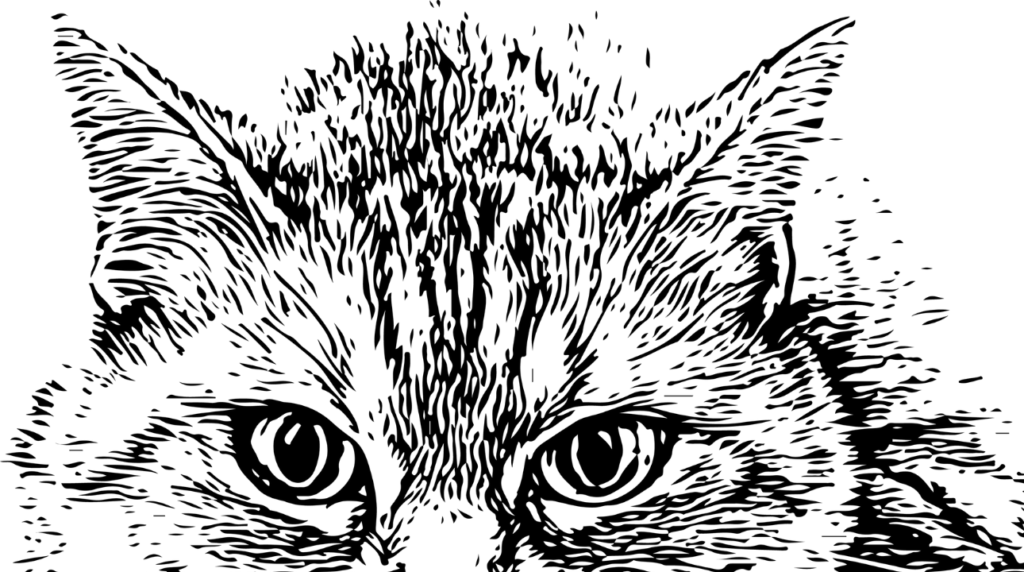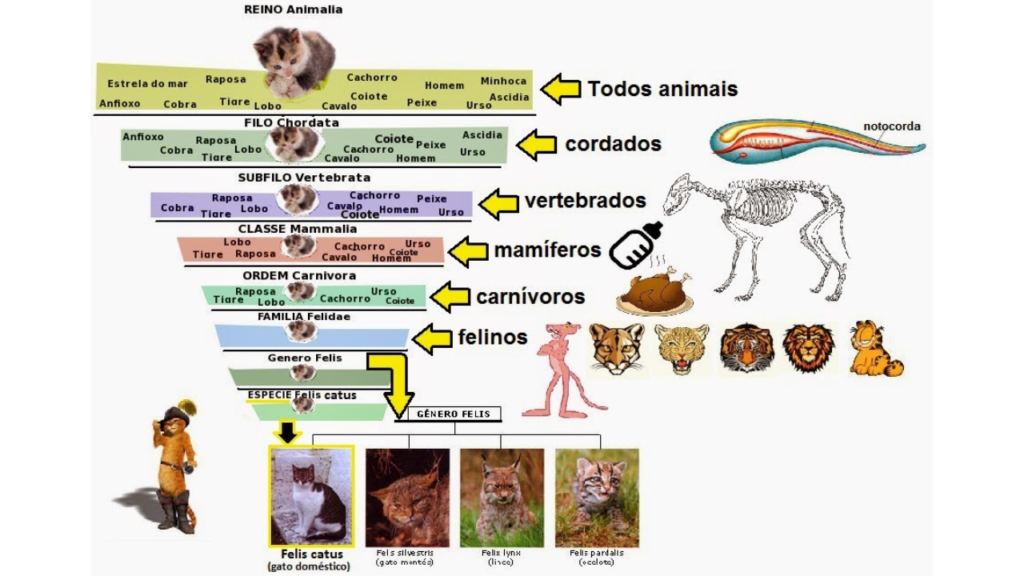The cats a carnivorous mammal belonging to the Felidae family, known for being an effective predator, hunting a variety of prey such as birds, lizards, rodents, and insects. This hunting skill is part of its instinctive nature and contributes to its independent and exploratory behavior.
As a pet, the cat is extremely popular, ranking second among the most common pets worldwide, behind only aquarium fish and dogs, according to research conducted by institutions in the United States.
Its popularity is due to both its adaptability and affectionate behavior, making it an ideal companion for many people.
The history of cats living with humans dates back about 3,500 to 8,000 years, when the first signs of domestication began to emerge.
The subfamily Felinae, which includes domestic cats, appeared approximately 12 million years ago, originating in sub-Saharan Africa and later spreading to other regions, including Egypt, where they were especially valued.
Over the centuries, cats spread across different cultures and continents, becoming symbols in mythologies and beliefs, in addition to playing important roles in pest control.
Today, their domestication is seen as an example of “self-domestication,” where felines gradually adapted to life alongside humans without forced interventions.
Without further ado, let’s now explore five fascinating facts about cats that you may not know. Also, check out the 5 most beautiful cats in the world.

1- Scientific Name
The scientific name for the feline is Felis catus, and the etymology of the term “cat” has various linguistic origins. The masculine term “cat” and its feminine form “gata” derive from the Proto-Germanic word kattuz.
On the other hand, its etymological origin is also connected to Late Latin, with the terms cattus or catta, first recorded in the works of the poet Martial in the 1st century AD. Before this, felines were referred to as feles, a word that originated the term “feline” in Latin, used to describe these animals.
The scientific classification of felines helped categorize various mammals within the Felidae family, which is divided into two subgroups: Felinae, including species such as the cheetah, lynx, and puma; and Pantherinae, covering animals like the tiger, leopard, lion, and jaguar.
This distinction shows the variety and distribution of felines worldwide, reflecting the diversity within the Felidae family.
The ancient Romans were the first to conceptualize the domestication of felines in Europe, although these animals were already appreciated and revered in Ancient Egypt, where they had significant cultural and religious importance.
The Egyptian influence on feline domestication extended to many other cultures over time, helping to spread these animals around the world as pets and pest hunters.
Moreover, the use of the word “cat” in different cultures and languages highlights how these felines have become an essential part of human life, whether as domestic companions or symbols of various beliefs and mythologies.
The history of felines is therefore deeply intertwined with the cultural and linguistic development of ancient civilizations up to the present day.
2 – Taxonomy

The taxonomy of domestic cats presents a detailed structure that places them among the various levels of biological classification. Here are the main aspects of these fascinating animals’ taxonomy:
Kingdom: Animalia – Felines belong to the animal kingdom, alongside all other living beings with complex and multicellular characteristics.
Phylum: Chordata – This phylum includes all animals with a dorsal nerve cord, which eventually develops into a backbone.
Class: Mammalia – Felines are mammals, characterized by having mammary glands and fur, like other members of this class.
Order: Carnivora – They are part of the carnivore order, meaning they are adapted to eat meat, with sharp teeth and a digestive system suited for it.
Family: Felidae – This family includes all felines, such as tigers, lions, leopards, and, of course, domestic cats. Compared to big cats, domestic cats are considered the most specialized members, with hunting behaviors adapted for smaller prey.
Genus: Felis – Within this genus are small cats, which share similar physical and behavioral characteristics.
Species: Felis catus – This is the scientific designation for domestic felines, indicating that they belong to a distinct species within the Felis genus.
3 – Domestication
The domestication of felines is still a somewhat misunderstood process, but it is believed to have occurred uniquely. Unlike many other domesticated animals, cats may have undergone a process of “self-domestication,” with little or no human intervention.
These wild felines, likely attracted to human settlements due to the availability of food, eventually developed a coexistence relationship that, over time, led to domestication.
The oldest fossil record of a feline is the Dinictis, dating back about 37 million years. This primitive animal is a distant ancestor that later gave rise to Proailurus, considered the common ancestor of all modern cat species.
Proailurus lived approximately 20 million years ago, marking the beginning of the feline evolutionary lineage, which later diversified into various species, including the domestic cat.
Studies suggest that the rapprochement between humans and cats began in regions like the Fertile Crescent, where the first agricultural settlements were formed. With the practice of agriculture, grain and food stocks attracted rodents, which, in turn, attracted wild cats.
This mutualistic relationship favored coexistence between humans and felines, as cats helped control the pest population and, in exchange, received shelter and food.
Moreover, the adoration of cats in Ancient Egypt played an important role in the dissemination of these animals. The Egyptians not only revered cats as gods but also used them to protect granaries from rodents.
This contributed to the spread of cats across various civilizations, solidifying their position as valuable companions to humans.

4 – Lifespan
These animals usually live 15 to 20 years, and the longest-living cat on record reached 38 years of age. When kept in a controlled environment, their life expectancy can be higher, as it reduces the risk of accidents, injuries in fights, or other street hazards.
Neutering is an effective measure to prevent them from leaving home, as it reduces the desire to escape in search of mates and, consequently, decreases the number of traumas. Additionally, neutering helps prevent cancer in reproductive organs such as the testes and ovaries.
To conserve energy, they spend most of the day sleeping, with a sleep period ranging from 12 to 16 hours. The normal body temperature of these felines is between 38 and 39°C, considered a fever when reaching 39.5°C and hypothermia when falling below 37.5°C.
Their resting heart rate ranges between 150 and 180 beats per minute, which can reach 220 during moments of excitement. Check out some bizarre facts about cats.
5 – Cats’ Biological Cycle
Females reach sexual maturity between 4 to 10 months, while males reach this phase between 5 to 7 months. The gestation lasts about 63 to 65 days, and a single litter can contain up to 8 kittens.
The reproductive process of cats is complex and fascinating, occurring throughout the year in reproductive cycles lasting 4 to 7 days.
During these cycles, female felines significantly change their behavior, vocalizing to attract nearby males. At the beginning of estrus, females emit characteristic meows and adopt specific postures that attract males around them.
These behaviors manifest their fertility and signal to males that they are ready for reproduction.
Males, attracted by females, engage in disputes, generating rivalries and territorial confrontations. The winner of these disputes earns the privilege of mating with the female. Initially, the female may reject the male, but over time, she may start to accept his approach, culminating in copulation.
It is important to note that cat mating can be accompanied by aggressive behaviors, such as growling and biting.
This aggression is a natural and intrinsic part of the reproductive process, functioning as a strategy that ensures the male remains coupled for the necessary time for fertilization. This behavior tends to cease as the female’s reproductive cycle ends.
An interesting peculiarity in the reproductive cycle of felines is that each fertilized egg can be sired by different males during the same cycle.
Thus, in a single litter, the kittens can have different fathers, a phenomenon known as polyandry. This evolutionary strategy may have increased genetic diversity, favoring the adaptation and survival of the offspring.
In summary, the reproductive cycle of kittens is a complex process, marked by male competition, female resistance, and peculiar behaviors.
6 – Global and Cultural Distribution
Cats are found in almost every region of the world, adapting to different climates and environments. Their presence is notable in both urban and rural areas, and they are found on various continents, playing roles ranging from companion animals to pest controllers. The global distribution can be analyzed in specific regions:
North America and Western Europe: In these regions, cats are highly popular as pets and are often seen in urban and suburban households.
Asia: In countries such as Japan and Thailand, cats hold deep cultural significance and are often considered lucky animals.
Middle East and Africa: Cats have a long history of living with humans, especially in Egypt, where they were revered in ancient times.
Latin America: While cats are becoming increasingly popular, especially in large cities, neutering and street animal care campaigns are still less common in some areas.
Oceania: In Australia and New Zealand, cats face ecological issues as the native fauna is not adapted to predators like cats.
7 – Phenotypic description
Currently, domestic felines exhibit a wide variety of physical characteristics resulting from centuries of selective breeding and crossbreeding.
Generally, cats are small to medium-sized animals, weighing between 5.5 and 15 pounds, although some breeds can be significantly larger or smaller.
Their musculature remains well-developed, providing agility and dexterity, while their lightweight, flexible skeleton allows for quick and precise movements. The long, mobile tail plays an important role in balance, helping them orient themselves during jumps and falls.
A cat’s eyes are one of its most striking features, particularly adapted for seeing in low-light conditions. With pupils that can dilate significantly, they are capable of capturing minimal light, enhancing night vision.
Eye colors vary widely, ranging from green to blue, amber, and more, depending on the breed and genetics. Whiskers, or vibrissae, continue to be an important feature, functioning as sensors that help the cat detect changes in its surroundings and gauge space.
The coat of modern cats is highly diverse, with variations in length, texture, and pattern. There are long-haired breeds like the Maine Coon, short-haired breeds like the Siamese, and even hairless breeds like the Sphynx.
Color patterns also vary greatly, from classic tabby stripes and spots to solid colors and tricolor combinations. This diversity is due to selective breeding and the mixing of different lineages over time, providing a wide range of options for cat enthusiasts.
Retractable claws are another physical feature that persists in modern felines. They are used for both defense and scratching activities, which help keep the claws sharp and mark territory. The behavior of scratching surfaces is a way to exercise muscles and maintain claw health.
Despite living in domestic environments, these physical and behavioral traits show that felines still carry traces of their wild ancestors, adapted for life in nature, even though they no longer need to use these traits for survival.
8 – Feline sense
A cat’s senses are highly refined and play a crucial role in their behavior and interaction with the environment. Their hearing is among the best in the animal kingdom, capable of detecting sounds at very high frequencies, up to 65 kHz, which far exceeds human capabilities.
This allows them to hear subtle noises, such as the movement of small rodents or the fluttering of a bird’s wings. Their ears are also highly mobile, able to rotate in different directions to precisely locate the source of sounds.
Feline vision is also adapted for hunting and exploration. While they cannot see in complete darkness, their night vision is far superior to that of humans, thanks to a reflective layer called the tapetum lucidum, which enhances light capture in low-light conditions.
During the day, their pupils constrict to avoid excessive light, forming a vertical shape that provides better focus on nearby objects. In terms of color perception, cats do not see the same range of colors as humans, but they can distinguish shades of blue and green more easily.
A cat’s sense of smell is one of its most important and refined senses. They have around 200 million olfactory receptors, compared to just 5 million in humans, allowing them to detect scents in very low concentrations.
This sense is used for communication and recognizing territory and other cats. Felines also possess a vomeronasal organ, known as Jacobson’s organ, which helps them detect pheromones, a crucial aspect for identifying chemical markers and better understanding their surroundings.
Cats’ taste is less developed compared to their sense of smell, but it still has some unique characteristics. They have a reduced sensitivity to sweet flavors and are more attracted to protein-rich foods. On the other hand, their sense of touch is highly sensitive, with their whiskers acting as extremely precise tactile sensors.
These help cats measure distances and detect small changes around them, facilitating navigation in tight spaces and the perception of nearby objects even in the dark. These acute senses reflect the heritage of their wild ancestors, adapted for a life of hunting and survival.
